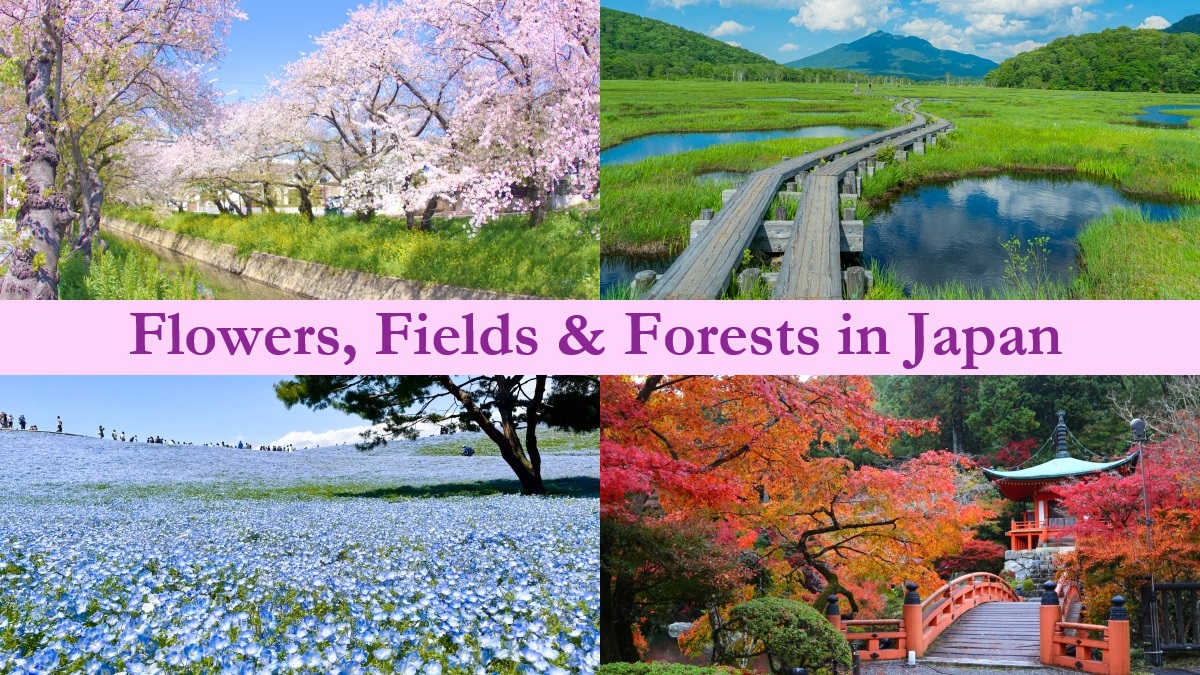Flowers, Fields and Forests in Japan
In Japan, 67 percent of the land is forests.
And, 75 percent of the land is mountains.
Grasslands and marshlands are also dotted in such land.
There are four seasons and various plants are growing.
Some fields and forests with valuable are preserved and they are good sightseeing spots.
And the artificial parks of beautiful plants are also attractive.
Sakura (Cherry blossom) in spring
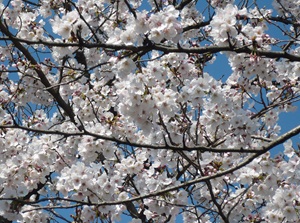
Japanese people have been loving cherry blossoms since ancient times.
The blooming announces the coming of spring, and the people renovate the spirits.
Cherry blossom viewing is a big event in spring for Japanese people.
Some varieties of cherry tree are in Japan, and early-blooming cherry trees are flowering in February.
Most popular cherry tree is "Somei-Yoshino" and a great many trees have been planted throughout Japan.
From late March to mid-April, the blossoms decotare cities and villages in Japan.
Please take a look at the following page and learn about cherry blossom in Japan.
Colored leaves in autumn
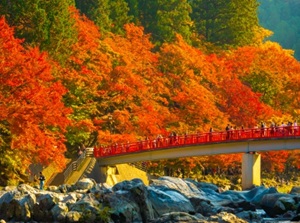
Korankei gorge in Aichi Prefecture
In late autumn, the leaves of deciduous trees change color.
The period is from October to November in mountainous areas and the northern part of Japan.
And the period is from mid-November to December in the plains in the southern part of Japan.
There are many kinds of tree in most forests, so we can see the colorful leaves such as red, orange, yellow, and green of evergreen trees.
In the period, many tourists visit picturesque spots for the viewing of colorful leaves.
Main places are the popular mountains, gorges, large Buddist temples, Japanese gardens, etc.
Flowers, Fields and Forests in each region
Hokkaido Tohoku Kanto Koshin-etsu Hokuriku Tokai Kansai Chugoku Shikoku Kyushu
Flowers, Fields & Forests in Hokkaido Region
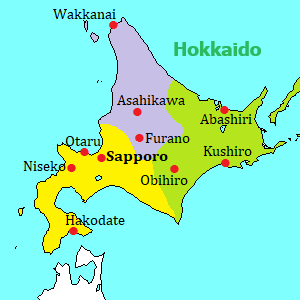
Campus of Hokkaido University (北海道大学) is just at north of Sapporo Station.
The original agricultural college was established in 1876, so the campus with farm is very wide.
It is like a natural park, and visitors can walk around there.
Maruyama Park (円山公園) is a park to the west of central Sapporo city.
Primary forest spreads around the park, and there are much green space in the park.
Biei (美瑛) is a town with many picturesque beautiful hills and un-Japanese landscape.
Various scenic spots are dotted in the town.
The best season is July and August.
Furano (富良野) is also a town with many scenic landscapes and is next to Biei town.
It is well-known as an area with lavender fields and The best season is July.
In winter, ski resort is open.
Obihiro (帯広) is a city positioned in the southeast part of Hokkaido, and large-scale farming is the main industry.
The climate creates beautiful color of flowers, so there are some sightseeing gardens around the city.
Kushiro Marsh (釧路湿原) is a broad marsh expanding to the north of Kushiro city, and it is the largest marsh in Japan.
Kushiro River snakes through the marsh and various plants and animals inhabit the marsh.
Meruhen no Oka (メルヘンの丘) a gently‐sloping hill with idyllic and beautiful scenery, and it is located to the south-southwest of the center of Abashiri city.
This scenery was used in the US-Japan joint movie "Dreams" in 1990.
Higashimokoto Shibazakura Park (東藻琴芝桜公園) is a flower park of "moss phlox" in the suburbs of Abashiri city.
Colorful flowers cover the hilly park.
The season is from the middle of May to early June.
Flowers, Fields & Forests in Tohoku Region
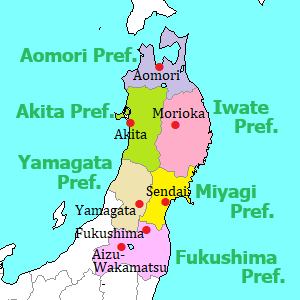
Shirakami-Sanchi (白神山地, Aomori & Akita Prefs.) is a mountain area, and the primeval forests are 130,000 hectares in area.
Old beech forests extend on the mountains, and it is designated a World Heritage Site.
Ishiwarizakura (石割桜, Iwate Pref.) is a unique cherry tree in Morioka city.
The tree grows in a cranny of a big rock.
In English, it is translated as "Rock-Breaking Cherry Tree".
Aoba Avenue, Jozenji Avenue (青葉通, 定禅寺通, Miyagi Pref.) are two main avenues in Sendai city.
There are many large Japanese zelkova trees along these avenues, and they are the symbol of the city.
Hanamiyama Park (花見山公園, Fukushima Pref.) is a flower park on a hill in the suburbs of Fukushima city.
It is a private ground of flower farms and the whole area is open to the public by the owner.
Miharu Takizakura (三春滝桜, Fukushima Pref.) is an old and big cherry tree in Miharu town.
It is a kind of weeping cherry and is over 1,000 years old.
Flowers, Fields & Forests in Kanto Region
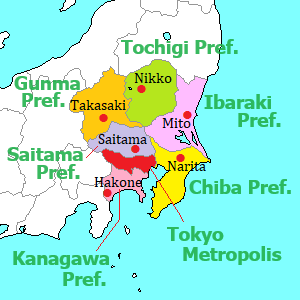
Oze marshland (尾瀬, Fukushima & Gunma Prefs.) is one of most popular marshlands in Japan.
The marsh is located about 1,400 meters above sea level and many precious plants grow.
It is forbidden to drive cars in this area.
Therefore, all visitors must tour around this large area on foot.
Cedar Avenue of Nikko (日光杉並木街道, Tochigi Pref.) is the old entrance road to the sacred city of Nikko.
The avenue had constructed in the 1620s, and 200,000 cedar trees were plnated.
Senjogahara (戦場ヶ原, Tochigi Pref.) is a marsh extending to the north of Lake Chuzenji near Nikko.
It is located at the level of about 1,400 meters and we can see alpine plants from June to August.
Kirifuri highland (霧降高原, Tochigi Pref.) is located to the north of Nikko.
The most popular spot is Kisuge-daira park and it is covered with countless yellow daylilies (Kisuge in Japanese) in summer.
Oze marshland Cedar Avenue of Nikko Senjogahara Kirifuri highland
Ashikaga Flower Park (あしかがフラワーパーク, Tochigi Pref.) is in Asikaga city.
Many beautiful flowers are seen throughout the year.
But, the great Japanese wisteria trellis is most popular and attractive.
Hitachi Seaside Park (国営ひたち海浜公園, Ibaraki Pref.) is one of National Government Parks in Japan.
There are wide flower gardens, grass fields and forests, and we can see the flowers throughout the year.
Especially, nemophila in spring is very popular.
Iris gardens near Junikyo are around big Tone River.
Suigo Sawara Ayame Park is in Sawara city, and Suigo Itako Ayame Garden is in Itako city.
From late May to mid-June, many Japanese irises are in bloom.
Junikyo are the small 12 bridges crossing over the canals, and visitors can visit by sightseeing boat.
South Boso Area (南房総, Chiba Pref.) is the southern end of Boso Peninsula.
The climate is warm, so many beautiful flowers bloom in late winter.
Shiramazu district is popular for the flower field.
Ashikaga Flower Park in Ashikaga city Hitachi Seaside Park Iris gardens around Junikyo South Boso Area
Flowers, Fields & Forests in Koshin-etsu Region
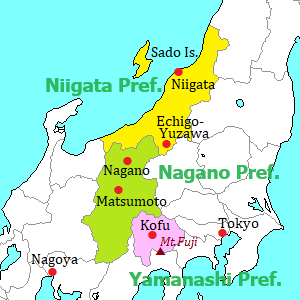
Hoshitoge Rice Terrace (星峠の棚田, Niigata Pref.) is one of the scenic rice terraces.
On the undulating land in the mountains, many small rice fields are arranged in a staircase pattern.
Fukushimagata (福島潟, Niigata Pref.) is a lagoon in the plain including Niigata city.
Over 450 kinds of plants grow wildly and more than 200 kinds of wild birds have been recognized in this lagoon.
Aokigahara (青木ヶ原樹海, Yamanashi Pref.) is the forest spreading at the northern foot of Mt.Fuji, and it was formed on the lava plateau after the eruption of Mt.Fuji in 864.
Some walking trails are set up, and we can enjoy walking in the woods.
Katsunuma (勝沼, Yamanashi Pref.) is a famous grape production area in Japan.
Katsunuma Budou-no-Oka (Katsunuma Grape Hill) is the tourist facility for this area.
Wide vineyard is seen and we can have a tasting of the wine.
Karuizawa (軽井沢, Nagano Pref.) is a famous resort town on the highland.
Western-style towns are dotted, and there are beautiful forests around them.
Shiga highland (志賀高原, Nagano Pref.) is the highland to the east of Nagano city.
It is located at the level of 1,000 to 1,800 meters.
There are many ski slopes, and beautiful forests, ponds and marshes spread.
Kirigamine (霧ヶ峰, Nagano Pref.) is a shield volcano and the beautiful highland spreads at a height of 1,500 to 1,900 meters on the west slope of the mountain.
It is filled with blossoming alpine plants in summer.
Kamikochi (上高地, Nagano Pref.) is a scenic valley around Hotakadake in Northern Alps.
It is an entrance place to Hotakadake, and general tourists can visit there.
Beautiful forests, ponds, streams, marshes are seen.
Takato Castle Ruins Park (高遠城址公園, Nagano Pref.) is in Ina city in trhe southern part of Nagano Prefecture.
Many cherry trees are planted in the ruin of the castle, and here is a place famous for its cherry blossoms.
Flowers, Fields & Forests in Hokuriku Region
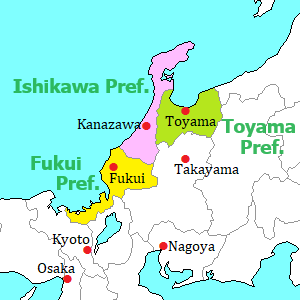
Tateyama Kurobe Alpine Route (Toyama Pref.) is a route crossing the Northern Alps from west to east.
The route passes beautiful Mount Tateyama (立山, 3,015 m) and huge Kurobe Dam.
There is no connecting road, so the tourists must use cable car, ropeway, special bus.
There are beautiful plateaus with grasslands and marshes and various alpine plants are seen.
Shiroyone Senmaida (白米千枚田, Ishikawa Pref.) is a rice terrace on the steep slope in Noto Peninsula facing the Sea of Japan.
It has 1,004 small fields on the slope.
Tateyama Kurobe Alpine Route Shiroyone Senmaida
Flowers, Fields & Forests in Tokai Region
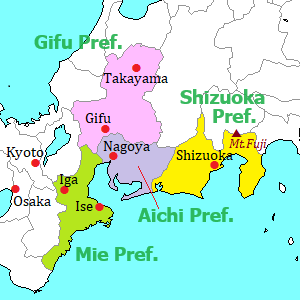
Asagiri highland (朝霧高原, Shizuoka Pref.) is the area on the western foot of Mt.Fuji.
The slope is very gentle, and there are many cattle ranches with broad meadow.
we can see Mount Fuji clearly and widely.
Nihondaira (日本平, Shizuoka Pref.) is an area around the top of hill in Shizuoka city.
Japanese rea farm spreads around the observatory and Mt.Fuji is seen from there.
Miho no Matsubara (三保の松原, Shizuoka Pref.) is a pine grove near beach in Shizuoka city, and it is one of the best places to see Mt.Fuji.
When Mt.Fuji was registered as a World Heritage Site, the reasons included this beach.
Asagiri highland Nihondaira Miho no Matsubara
Usuzumi-zakura (淡墨桜, Gifu Pref.) is an old big cherry tree.
It is more than 1,500 years old and it began to be dying around 1913.
But many people brought it back to life.
Nabana no Sato (なばなの里, Mie Pref.) is a flower park located in Nagashima district in Kuwana City.
A lot of colorful flowers bloom in the wide gardens.
Illumination held from mid-October to early May is very popular.
Maruyama Rice Terrace (丸山千枚田, Mie Pref.) is a scenic rice terrace and is located to the west of Kumano city.
About 1,340 small rice fields are arranged in a staircase pattern on the the mountain slope.
Usuzumi-zakura Nabana no Sato Maruyama Rice Terrace
Flowers, Fields & Forests in Kansai Region
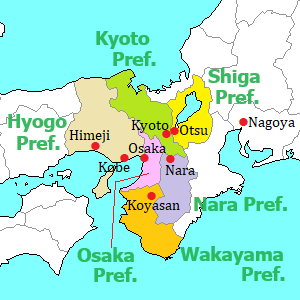
Wazuka tea plantations (和束の茶畑, Kyoto Pref.) are the fields of Japanese green tea in Wazuka town in Uji city.
The tea has been produced since ancient times, the scenery of the fields is beautiful.
Mount Yoshino (吉野山, Nara Pref.) is a mountain area that the mountain worshippers has trained since the 7th century.
There are about 30,000 cherry trees in the valley and we can see the mountain covered with cherry blossoms in April.
Flowers, Fields & Forests in Chugoku Region
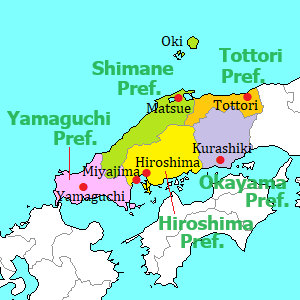
Bitchu-Kokubunji temple (備中国分寺, Okayama Pref.) is a Buddhist temple in Soja city and was founded in 741.
The five-story pagoda is the symbol of this temple and the scenery of idyllic farming area is attractive.
Ini rice terrace (井仁の棚田, Hiroshima Pref.) is one of the scenic rice terraces in Hiroshima Prefecture.
324 small rice fields are arranged in a staircase pattern.
Akiyoshidai (秋吉台, Yamaguchi Pref.) is is the largest karst tableland in Japan.
Countless limestone pinnacles are in the undulating grassland and there are many caves under the ground.
Bitchu-Kokubunji temple Ini rice terrace Akiyoshidai
Flowers, Fields & Forests in Shikoku Region

Ritsurin Garden (栗林公園, Kagawa Pref.) is in Takamatsu city, and it was originally a garden of a samurai house built in the 1680s.
It is the largest garden in Japan and there are many hills, ponds, and wide forests.
Shodoshima (小豆島, Kagawa Pref.) is the second largest island in Seto Inland Sea, and the cultivation of olive is well-known in the mild climate.
There is Shodoshima Olive Park, and the olive fields are seen.
And, There is Nakayama Rice Terrace in the mountain.
Flowers, Fields & Forests in Kyushu Region
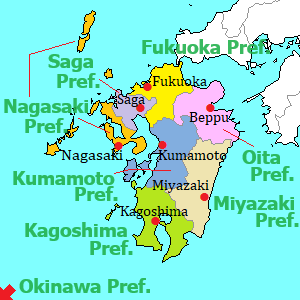
Umi no Nakamichi (海の中道, Fukuoka Pref.) is a sand bank near Fukuoka city.
There are wide flower gardens and large grassy fields, and amusement park, zoo, etc. are set up.
Shikanoshima is connected to the sand bank, and the golden seal given from China in the 1st century was excavated in the island.
Nokonoshima (能古島, Fukuoka Pref.) is a small island in Hakata Bay.
The flower gardens in the island are popular, and various flowers bloom throughout the year.
Kawachi Wisteria Garden (河内藤園, Fukuoka Pref.) is a private garden of wisteria near Kitakyushu city.
22 kinds of wisteria flowers bloom in the garden from late April to early May, and you need to make a reservation in the season.
Hamanoura Rice Terrace (浜野浦の棚田, Saga Pref.) is on the slope in a narrow valley near a small inlet og Genkai Sea.
283 small rice fields are arranged in a staircase pattern.
Yakushima (屋久島, Kagoshima Pref.) is an island with very high and steep mountains.
Rich forests cover the whole island.
Yakusugi, a kind of Japanese cedar, grow in the forest and the trees over 2,000 years old are quite common.
Umi no Nakamichi Nokonoshima Kawachi Wisteria Garden Hamanoura Rice Terrace Yakushima

